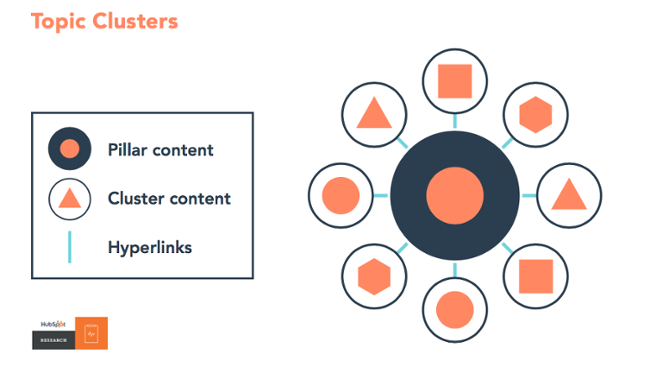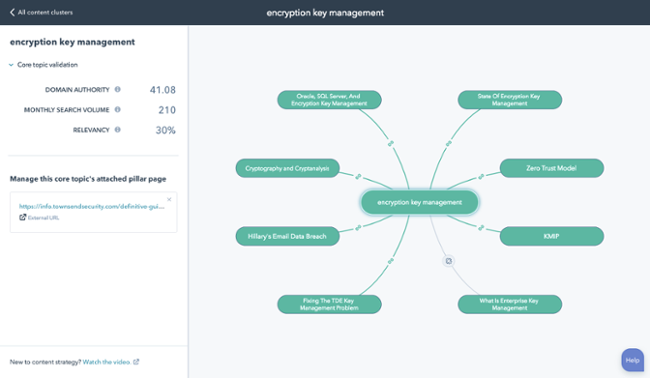You know how important content is since it’s the voice of your business across all communication platforms both digitally and in real life. So how do you manage it all? You’ve seen competitors in the channel do it and do it well. From podcasts, to blog posts, to video: Where do you begin? How do you choose your area to shine?
But before getting to the ‘how’ of it all, let’s cover why you’d even want to tackle this task. The brass ring for MSPs and VARs when building out digital communications is coming up at the top of search engine results for words and phrases your ideal customer uses to find the solutions you offer. This one thing has transformed many businesses in the channel and with a clear, consistent strategy you can achieve similar results.
Essential to a Solid Content Strategy: Topic Clusters
Simply put, you begin with a content pillar or an authoritative piece of information that is the center of your content marketing strategy. As with any pillar, the purpose is to support key elements of a structure. In this case, the key elements your content pillar supports would be adjacent content or off-shoots of the pillar subject matter.
Here’s an example:
| Pillar Content |
Cluster Content |
| 2,500-word blog article on the application of IoT in enterprises |
- Video on IoT and fog computing in agriculture
- Infographic highlighting IoT business model
- Case study of an enterprise-level client successfully leveraging IoT
- A white paper outlining the financial viability of IoT applications for the next five years
- Blog article describing how to take the first steps in implementing IoT in enterprises
|
Here is a graphic provided by Hubspot to illustrate the content clusters concept:

In this example, the supporting cluster content is related to the pillar and the expectation is that all the content within the topic cluster will be linked to the pillar content and vice versa.
Some benefits of using topic clusters include:
- Powerful ways to organize content
- Showcasing your depth of knowledge in your field
- Making your content attractive to Google
- The ability to use topic clusters alongside tags and integrate them as dynamic / recommended content within your site
As you’re thinking of integrating topic clusters into your content marketing efforts, remember these considerations:
People hate to be sold but they love to buy.
Consumers come to your brand already educated about who you are and what you do.
Give potential and existing customers your version of the story about your brand by presenting hard-hitting information that solves the biggest challenges they’re facing right now.
The Best Topic Clusters Solve Problems
.jpg?width=1140&name=Subpage-1-(under-secret-to-mastering-topic-clusters).jpg)
To master topic clusters, you’ll need to focus on creating pillar content around which your entire content marketing strategy is to be built. Keep in mind as with any building, you’ll need more than one pillar. The example above employed IoT but the MSP in that example helps clients with many other elements of technology including cloud/data center, and security. Create pillars for every offering in your business.
Start with the Problem: To create powerful pillar content, you need to display a keen understanding of the core challenges your audience is facing. And you’ll need to exhibit how your firm helps solve/address that challenge. The best way to get this information is to keep your eye out for what your customers are talking about.
Finding the challenge:
- Visit popular blogs. A great tool for keeping up with the blogs related to the channel is a tool called Feedly. It gives you a daily list of the latest blog posts/news from thought-leaders in the industry so you know who’s doing what in the industry.
- Survey your customers. In this instance keep things as simple and friendly as possible. Look at your survey as a way to check in with your customers and find out how you can provide them with more value in your product offerings.
- Listen for challenges during customer meetings and industry/networking events. Have a special ear for a nagging difficulty your existing and potential customers mention at industry events. Many times when we’re around peers we relax and actually share the biggest sticking points in our processes. The thin they mention in these meetings could be the source of one of your pillar content pieces.
Key Takeaway:
You’re mining for the gold of ‘I wonder how I can eliminate ___.”
Whatever your customer uses to fill in that blank is the topic of your next blog post or content piece.
.jpg?width=1140&name=subpage-2-(under-reach-out-to-experts).jpg)
Develop Supporting Content
Link minor content to the core pillar content you’ve created. Got videos? Tutorials? Fact sheets? Other useful things on your website or other things scattered in the ether gathering dust? Good.
Blow off the cobwebs and get ready to put that information in the spotlight as well. Link to this content in your pillar content piece. Yes, it sounds like work. That’s because it is. But the payoff is that you’ll have a distinct advantage over competitors.
Here’s what a Topic Cluster looks like in HubSpot:

Next Steps: Reach Out to the Experts
If you’re starting from scratch in creating a voice for your company online, you’ll want to start with four key elements.
- Ideal customer persona
- Target keywords
- Blog marketing strategy
- Social media marketing strategy
All four of these areas require a strategy of their own that will then roll up into your overall content marketing strategy. If it sounds like a lot of work, that’s because it is. But take heart, you don’t have to go it alone.
Presh Marketing Solutions is an agency partner with HubSpot with full access to the Topic Cluster and content marketing strategy tool within that system. If creating a full content marketing system appears to be a daunting task, fear not. There’s help available to you. Work with us to build out your content strategy.
